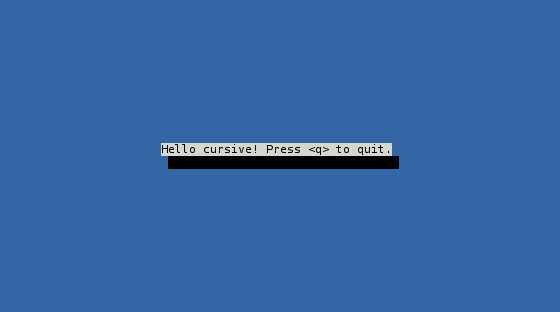4.6 KiB
Starting with cursive: (1/3)
Target goal
In this first tutorial, we'll learn the basics of cursive, and write a very basic first application:
extern crate cursive;
use cursive::Cursive;
use cursive::views::TextView;
fn main() {
let mut siv = Cursive::default();
siv.add_global_callback('q', |s| s.quit());
siv.add_layer(TextView::new("Hello cursive! Press <q> to quit."));
siv.run();
}
Run this application, and you should have something like that:
Now that you have an idea of what we'll do, let's start from scratch.
Project configuration
Let's create a new project (this is basic cargo stuff I hope you're familiar with):
% cargo new --bin cursive_example
Now, we'll add cursive to the list of dependencies in Cargo.toml:
[package]
name = "cursive_example"
version = "0.1.0"
[dependencies]
cursive = "*"
Finally, update src/main.rs to import it:
extern crate cursive;
fn main() {
}
This simple application is now ready to use cursive. So let's do just that!
The Cursive root
The cursive library is configured through a main Cursive root.
A typical cursive application will consist of three phases,
all centered around this object:
- Create a
Cursiveobject. - Configure the
Cursiveobject. - Run the
Cursiveobject.
Of these, the configuration phase is often the largest one, so let's skip it for now.
In its simplest form, a cursive application is therefore:
extern crate cursive;
use cursive::Cursive;
fn main() {
let mut siv = Cursive::default();
siv.run();
}
It's rather easy to identify the two steps involved.
If you run this, you'll get an empty blue terminal, with no way of properly
leaving the application (you'll have to press <Ctrl-C> to kill it).
Interactivity
Let's first add a way to stop the application. We want to quit when the user
presses the letter q.
Cursive sends an event for every user input; most of these are just ignored
and have no effect. The Cursive root has a add_global_callback method to
call a function anytime a certain event is fired.
This method takes 2 arguments: a trigger, and a callback.
- The trigger needs to implement
Into<event::Event>. In addition toevent::Eventitself, this includesevent::Key, or simplychar. These will trigger when the corresponding key (or letter) is pressed. - The callback should be a function taking a
&mut Cursiveas argument. Here, we want to quit, so we'll useCursive::quitin a closure:|s| s.quit().
In the end, we have:
extern crate cursive;
use cursive::Cursive;
fn main() {
let mut siv = Cursive::default();
siv.add_global_callback('q', |s| s.quit());
siv.run();
}
As expected, running it show no visible change, but hitting the q key at
least closes the application.
Views
Views are the main components of the user interface in a cursive
application. At their core, they define what to draw in a rectangle of the
terminal. For instance, a view can print a line of text, or a checkbox, etc.
Here, we'll be using a TextView to show a short message. TextView itself
can also deal with long text and do proper word-wrapping, but we won't need
that today.
The TextView constructor just takes the text to use: TextView::new("...").
The Cursive root itself uses a StackView on the entire screen. This
StackView unsurprisingly stacks views in layers. It starts empty, so we'll
just need to add our TextView as a layer. The Cursive::add_layer does
exactly that.
Once we've added this line, our first application is complete:
extern crate cursive;
use cursive::Cursive;
use cursive::views::TextView;
fn main() {
let mut siv = Cursive::default();
siv.add_global_callback('q', |s| s.quit());
siv.add_layer(TextView::new("Hello cursive! Press <q> to quit."));
siv.run();
}
